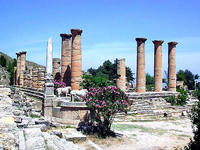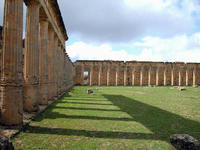You are in: Africa -> Libya -> Archaeological Site ... , and traditional search or Image Gallery will yield results of this site only
Archaeological Site of Cyrene
| Site number: | 190 |
|
| Type of site: | Heritage in danger | |
| Date: | ca. 365 | |
| Date of Inscription: | 1982 | |
| Location: | Africa, Libyan Arab Jamahiriya, District of Ghebel Akhdar | |
Up to 75 images are shown here. Click on each for more details or on Image Gallery for more images.
Six official UN languages:
Arabic,
Chinese,
English,
French,
Russian,
Spanish
Other languages: Breton, Catalan, Dutch, German, Hebrew, Indonesian, Italian, Japanese, Lithuanian, Norwegian-bokmål, Polish, Portuguese, Swedish
Other languages: Breton, Catalan, Dutch, German, Hebrew, Indonesian, Italian, Japanese, Lithuanian, Norwegian-bokmål, Polish, Portuguese, Swedish
| Description: | Cyrene, Thera’s Greek colony, was one of the Hellenic world’s primary cities. Until the earthquake of 365, it remained a great Romanized capital. Its ruins hold testimony to a thousand years of history; renowned since the 18th century. --WHMNet paraphrase from the description at WHC Site, where additional information is available. | |
| Cyrene, the ancient Greek city (in present-day Libya) was the oldest and most important of the five Greek cities in the region and gave eastern Libya the classical name 'Cyrenaica' that it has retained to modern times. It lies in a lush valley in the Jebel Akhdar uplands. It was named after a spring, Kyre, which the Greeks consecrated to Apollo. Cyrene was founded as a colony of the Greeks of Thera (modern Santorini), traditionally led by Battus I from Thera, in 630 BC ten miles from its port, Apollonia (Marsa Sousa). Details concerning the founding of the city are contained in Book IV of the Histories of Herodotus. It promptly became the chief town of the ancient Libyan region between Egypt and Carthage (Cyrenaica), kept up commercial relations with all the Greek cities, and reached the height of its prosperity under its own kings in the 5th century BC. Soon after 460 BC it became a republic; after the death of Alexander the Great (323 BC) it passed to the Ptolemies and fell into decay. --Wikipedia. Text is available under the Creative Commons Attribution-ShareAlike License. | ||
| Source: | http://whc.unesco.org/en/list/190 | |
| Reference: | 1. UNESCO World Heritage Center, Site Page. | |




























